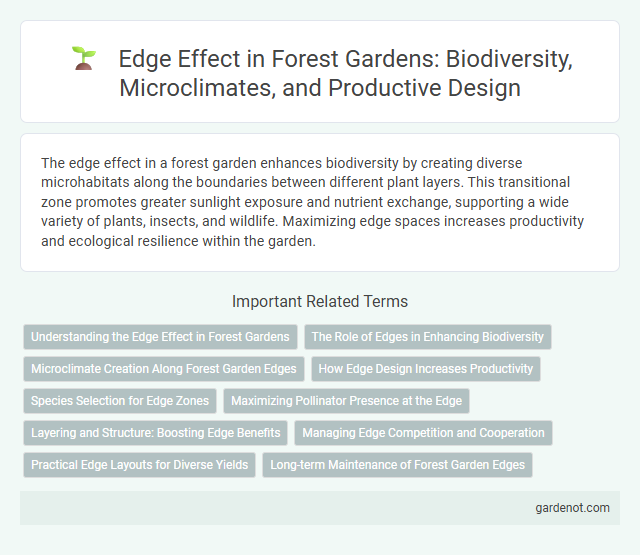The edge effect in a forest garden enhances biodiversity by creating diverse microhabitats along the boundaries between different plant layers. This transitional zone promotes greater sunlight exposure and nutrient exchange, supporting a wide variety of plants, insects, and wildlife. Maximizing edge spaces increases productivity and ecological resilience within the garden.
Understanding the Edge Effect in Forest Gardens
The edge effect in forest gardens enhances biodiversity by creating diverse microhabitats where two or more ecosystems intersect, promoting greater species variety and ecological interactions. This phenomenon increases sunlight exposure, temperature variation, and nutrient availability, benefiting both plants and wildlife in these transitional zones. Understanding the edge effect enables gardeners to design forest gardens that optimize space, improve pollination, and boost overall productivity.
The Role of Edges in Enhancing Biodiversity
Edges in forest gardens create unique microhabitats that support increased species diversity by blending characteristics of adjoining ecosystems. These transition zones foster interactions between plants, animals, and microorganisms, enhancing nutrient cycling and pollination processes. The ecological complexity of edges promotes resilience, making forest gardens more productive and sustainable.
Microclimate Creation Along Forest Garden Edges
Forest garden edges create unique microclimates characterized by increased sunlight, humidity, and wind protection, fostering diverse plant growth and enhanced biodiversity. This edge effect promotes nutrient cycling and supports beneficial insects, improving overall ecosystem resilience. Microclimate variation along forest garden boundaries optimizes conditions for both shade-tolerant and sun-loving species.
How Edge Design Increases Productivity
Edge design in forest gardens leverages the edge effect by maximizing sunlight exposure and microclimate diversity, leading to increased plant productivity and biodiversity. By arranging plants with varied heights and growth habits along garden edges, resources such as light, water, and nutrients are more efficiently utilized. This strategic placement enhances yield by promoting complementary interactions between species, improving overall ecosystem resilience.
Species Selection for Edge Zones
Species selection for edge zones in forest gardens maximizes biodiversity by incorporating plants that thrive in transitional environments between forest interiors and open spaces. Choosing species with complementary light, moisture, and nutrient requirements enhances resilience and productivity along edges where microclimates vary. Incorporating native shrubs, sun-tolerant herbs, and shade-adapted trees optimizes ecological interactions and supports pollinators, beneficial insects, and wildlife in these diverse edge habitats.
Maximizing Pollinator Presence at the Edge
Maximizing pollinator presence at the edge of a forest garden involves planting diverse, nectar-rich flowering species that bloom sequentially to provide a consistent food source. Incorporating native plants and structural diversity enhances habitat suitability for various pollinators, increasing pollination efficiency and biodiversity. Managing microclimates and reducing pesticide use at the edges further supports a thriving pollinator community essential for forest garden productivity.
Layering and Structure: Boosting Edge Benefits
In forest gardens, the edge effect enhances biodiversity and productivity by increasing sunlight and microclimate variation along boundaries. Layering plants vertically--from ground covers to tall canopy trees--maximizes space and resource use within these edge zones. Structured layering encourages species interaction, improving nutrient cycling and resilience in the garden ecosystem.
Managing Edge Competition and Cooperation
Edge effect in forest gardens enhances biodiversity by creating diverse microhabitats where different plant species interact. Managing edge competition involves strategic planting of complementary species to reduce resource conflicts while promoting beneficial cooperation such as nutrient sharing and pest resistance. Effective edge management maximizes productivity and ecological balance within forest garden ecosystems.
Practical Edge Layouts for Diverse Yields
Optimizing edge effects in forest gardens increases biodiversity and productivity by designing practical edge layouts that maximize sunlight exposure and microclimate benefits. Integrating diverse plant species at the boundaries creates multifunctional zones that support pollinators, pest control, and nutrient cycling. Strategic layering of trees, shrubs, and groundcovers along edges enhances yields through complementary growth patterns and resource use.
Long-term Maintenance of Forest Garden Edges
Forest garden edges experience increased biodiversity and productivity due to the edge effect, where two ecosystems meet, fostering unique microclimates and resource availability. Long-term maintenance of these edges involves regular pruning, selective planting, and soil management to sustain nutrient cycling and prevent invasive species encroachment. Consistent monitoring and adaptive management ensure the stability and resilience of the forest garden ecosystem over time.
Edge effect Infographic

 gardenot.com
gardenot.com